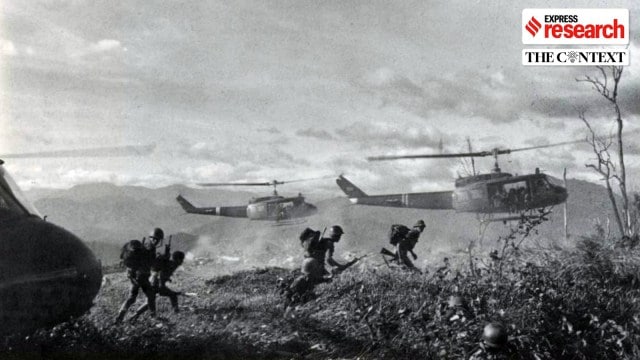With the air in Delhi becoming an unbreathable haze of dust and pollutants leaving residents gasping for relief, cloud seeding or artificial rain is being touted as a short-term solution to clear the smog. While the effectiveness of this solution in the national capital is debatable, cloud seeding was first conceived in the mid-20th century and was quickly weaponised during the Vietnam War, when the scientific breakthrough was transformed into a hazardous tool of weather manipulation.
At a star-studded dinner on September 30, 1946, in New York City, Radio Corporation of America president David Sarnoff made a bold claim: weather control was no longer science fiction. “For example,” Sarnoff said, “man may learn how to deflect air movements with consequent changes in weather and he may discover how to neutralise a storm or detour it from its course.” He predicted that people might soon choose weather like a radio station. Sarnoff’s vision reflected the post-war optimism in America that science and technology could solve any problem — man-made or natural.

Commercial weather control, especially cloud seeding, even appeared in cartoons. In Looney Tunes’ 1936 short film Porky the Rain-Maker, Porky faces a drought and buys ‘rain pills’ from Dr Quack, who launches them into the sky with a peashooter, causing immediate rainfall. Similarly, in Walt Disney’s Comics and Stories (1953), Donald Duck becomes M.R.M. (Master Rainmaker), having perfected the art of rainmaking.
Story continues below this ad
Cloud seeding is often seen as a ‘silver bullet’ for weather modification. It involves adding silver iodide to clouds, helping form ice crystals and causing water to turn into rain or snow. The goal is to increase precipitation by ensuring more rain reaches the ground compared to the amount of water vapour in the clouds.
The concept of cloud seeding was discovered by Vincent Schaefer in 1946 while working at the General Electric Research Laboratory in Schenectady, New York. In an attempt to create artificial clouds in a cold chamber, Schaefer added dry ice to further cool the compartment, and a cloud instantly formed around the dry ice. The microscopic ice crystals in the dry ice provided a perfect seed for water vapour to condense.
Together, Schaefer and physicist Bernard Vonnegut flew in a single-engine plane to find suitable clouds. After finding the right conditions, Schaefer released three pounds of dry ice shavings from the cockpit, and scientists on the ground watched as snow fell from the seeded cloud. Later, Vonnegut discovered that silver iodide was more effective than dry ice in nucleating clouds.
Following these breakthroughs, the US Army Signal Corps signed a contract with General Electric in February 1947 for fog and cloud-dispersion research. It was initially called the ‘snow project’ and later renamed Project Cirrus, historian Kristine C Harper notes in Make It Rain: State Control of the Atmosphere in Twentieth-Century America. “In their joint statement, the Signal Corps and General Electric announced that their research might lead to the ‘manipulation of gigantic natural forces for the benefit of mankind everywhere’,” Harper states.
Story continues below this ad
Weather control in warfare
Through Project Cirrus, America learned how weather control could be used in warfare to lower enemy morale by creating harsh weather, damaging crops to disrupt food supplies, and triggering snow to uncover hidden positions and enemy activity along supply routes.
“For postwar America’s military and civilian leaders willing to exploit any advantage in the nation’s increasingly adversarial relationship with the Soviet Union, the possibility of ensuring national security by controlling the weather was too tantalizing to pass up,” says Harper.
Cloud seeding gained international attention during the Cold War as governments explored weather control for military and agricultural purposes. By the 1960s, the technique was deployed in the Vietnam War (1955-1975) with the US Department of Defense seeding clouds to extend the monsoon season along the Ho Chi Minh Trail during Operation Popeye (1967-72). What began as the experimental Project Popeye evolved into Project Compatriot, turning weather into a weapon.
Harper notes that the technique proved effective in Vietnam and Laos due to the large cumulus clouds before and after the summer monsoon. When silver iodide-filled canisters were released into the clouds, they “blew up” into a distinctive shape. The resulting continuous rainfall slowed truck traffic on the trail, successfully denying its use as a supply route.
Story continues below this ad
“The charge will be made that we [the United States] have been the first to open a ‘Pandora’s box’ of unknown threats to future civilizations,” Harper records Donald Hornig, Science Adviser to US President Lyndon B Johnson, as writing.
As they brainstormed how to defend the potential loss of life, land, and crops caused by rainfall from cloud seeding in North Vietnam, Walt Whitman Rostow, national security advisor to President Johnson, argued, says Harper, “Our only defense would be …that rainmaking was being used as a humane and effective non-lethal supplement to our bombing of the North.”
The US Air Force’s 54th Weather Reconnaissance Squadron, which carried out most of these operations, claimed their goal was to “make mud, not war”, Harper states.
A climate adaptation strategy
After the Vietnam War, the United Nations General Assembly adopted the 1976 ‘Convention on the Prohibition of Military or Any Other Hostile Use of Environmental Modification Techniques’ treaty, which aimed to restrict weather modification to peaceful purposes. By the 1980s, cloud seeding fell out of favour due to ethical and environmental concerns.
Story continues below this ad
Despite lingering scientific uncertainties, however, cloud seeding has returned as a climate adaptation strategy. Today, it is widely used in arid regions to boost precipitation artificially and is also employed to clear airport fog, fight forest fires, suppress hail, and even divert rainfall, as seen during the 2008 Beijing Olympics.

































